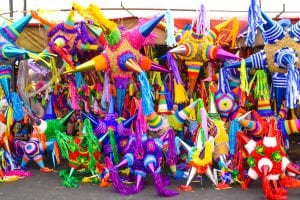Los múltiples orígenes de la piñata
Hay muchas historias sobre el origen de la piñata. Para algunos, las piñatas se originaron en China, donde los registros muestran que el explorador italiano Marco Polo observó figuras de vacas, bueyes y búfalos cubiertos con papel de colores para celebrar el Año Nuevo Chino. Fue documentado cómo la gente golpeaba con fuerza estas figuras con palos de varios colores hasta que salieran semillas de estas “piñatas chinas”.
Marco Polo ha sido considerado como la persona que llevo esta tradición a Italia. Cuando las piñatas llegaron a Europa en el siglo XIV, se adaptaron a la celebración de la Cuaresma. El primer domingo se convirtió en "Domingo de Piñata". En Italia, la palabra "pignatta" significa "olla frágil". Esta tradición luego llego a España, donde al primer domingo de Cuaresma se le llamó "Danza de la Piñata". En España se usaba una olla de barro que era decorada con cintas y se le añadían papeles con flecos y se envolvía alrededor de la olla.
Para algunos historiadores, sin embargo, la tradición de la piñata en México se originó de los antiguos mayas y aztecas, quienes jugaban a un juego que consistía en romper una olla de barro que se balanceaba por medio de una cuerda, con los ojos vendados. Estas ollas de barro se colocaban en un poste en el templo que en ocasiones se llenaba de granos o frutas que representaban la abundancia o los favores otorgados por el dios. A la llegada de los españoles a México, los misioneros también trajeron la versión europea de la piñata que se utilizó para atraer a los nativos a sus ceremonias católicas.
La piñata como la conocemos hoy fue introducida por los misioneros españoles en México alrededor del mismo tiempo en el que las posadas se originaron en Acolman de Nezahualcóyotl, Estado de México. Las primeras piñatas originalmente tenían la forma de una estrella con siete picos. Cada pico representaba los siete pecados capitales y los colores brillantes de la piñata simbolizaban la tentación.
Hoy en día, niños y adultos golpean la piñata hasta que se rompe y los dulces y juguetes que están dentro de ella se derraman. Hasta hoy en día las piñatas suelen a tener la forma de estrella y se utilizan para diversas celebraciones, aunque también hay piñatas con formas y personajes muy creativas. Mientras se acercan las fiestas decembrinas, ¿romperá una piñata? Si es así, ¿qué le pondrá adentro?
The Many Origins of the Piñata
There are many stories around the origin of the piñata. For some, piñatas originated in China where records show Italian explorer Marco Polo observed Chinese figures of cows, oxen and buffaloes covered with colored paper to celebrate the New Year. It was observed how people knocked these figures hard with sticks of many colors until seeds came out of them.
Marco Polo has been widely considered to be the individual that exported this tradition to Italy. When piñatas arrived in Europe in the 14th century, they were adapted to the celebration of Lent. The first Sunday became ‘Piñata Sunday’. In Italy the word ‘pignatta’ means “fragile pot.” This tradition then spread to Spain where the first Sunday in Lent was called the ‘Dance of the Piñata’. In Spain they used a clay container called “la olla”, the Spanish word for pot, which they decorated with ribbons and fringed paper were added and wrapped around the pot.
For some historians, however, the tradition of the piñata in modern-day Mexico dates to the ancient Mayans and Aztecs, who played a game that consisted of breaking a pot of mud that was balanced by means of a rope, while wearing blindfolds. These clay pots were put on a pole in the temple which at times were filled with grain or fruits that represented the abundance or favors granted by the god. Upon the arrival of the Spanish in Mexico, the missionaries also brought the European version of the piñata which was used to attract the natives to their Catholic ceremonies.
The piñata as we know it today was introduced by the Spanish missionaries in Mexico around the time las posadas originated in Acolman de Nezahualcóyotl. This piñata was originally shaped like a star with seven peaks. Each spike represented the seven deadly sins and the bright colors of the piñata symbolized temptation.
Today children and adults hit the piñata until it is broken and the candy and toys that typically fill them pour out. They are usually in the shape of a star and are used for various celebrations. As we prepare for the holidays, will you be breaking a piñata? If you are, what will you put inside of it?
Sources:



